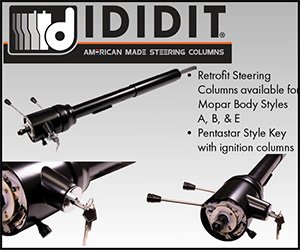
Between our original 2014 photoshoot and the 2025 purchase of Project Rara Hemious Birdicus, a few critical under hood components quietly disappeared, including the battery hold-down assembly. The existing battery, stamped with a 2018 date code, hinted at a prior replacement. Most likely, the original hold-down was either damaged during that swap or omitted during installation.
Above Left: The Road Runner was missing parts or had damaged ones, so we picked up from Classic Industries a positive and negative battery cable, a battery hold-down, and a clip to retain a wire from the positive cable. Above Right: The battery cables were labeled from the factory with a “P” for positive (shown) and a “N” for negative.
Above Left: The battery hold-down was missing. The new Classic Industries hold-down came with the bracket, the J-hooks, washers, and wing nuts. Above Right: The single-wire neutral safety switch required a clip, which was missing, so we picked one up from Classic Industries.
To compound the problem, the B+ battery cable had been fitted with a temporary terminal end. While functional in the short term, such “quick fixes” often become permanent, introducing corrosion-related electrical problems, and it stands out like a sore thumb in an otherwise clean engine bay.
Above Left: The battery appears to have been replaced in 2018, and the hold-down was not reinstalled at that time for unknown reasons. Above Center: The Classic Industries battery hold-down fits just like the factory unit. Above Right: After looking at several magazines, we determined the rearmost hole on each side of the hold-down bracket was the one that the factory used.
In a car like our Hemi Road Runner, where attention to detail matters, these kinds of problems had to be addressed. Enter Classic Industries, who had everything we needed: a reproduction battery hold-down kit, complete with bracket, J-hooks, washers, and wing nuts, as well as factory-correct positive and negative battery cables.
Above Left: The Classic Industries negative battery cable fit the battery terminal correctly. Above Center: The cable end attached to the cylinder head was painted orange to match the way the factory did it in 1968. Above Right: The positive cable had a temporary terminal end, which is an invitation for starting and charging system problems, and it looks terrible no matter what car it is on.
The installation of the battery hold-down was refreshingly straightforward. We placed the bracket across the top of the battery, aligned it with the tray, and slid the J-hooks through the bracket and into their corresponding slots on the inner fender and tray flange. With the washers positioned, we spun on the wing nuts and evenly snugged them down. Just like that, we had the battery solidly locked in place, no more rattles, no more worries.
Above Left: The factory positive cable extended from the battery to the fender apron. For some reason, the wires had been relocated, and the factory clips had been replaced with zip ties. Above Center: Part of the harness ran from the battery to the starter, while some of the harness extended to the starter relay. Above Right: The cables terminated at the starter relay, apart from the white wire that was routed to the bulkhead connector. That wire presented some difficulty for us, which required some inquiries and research to resolve (more explained in the later photos).
We encountered one small snag: the new bracket featured two mounting holes on each side, just like the factory one, which raised a question about the correct orientation. To solve it, we consulted our archive of period-correct under-hood photos from Hot Rod and Car Craft issues circa 1967–1968. Those images confirmed that the rearmost holes were used from the factory, so we followed their lead.
Above Left: To remove the positive harness, we started by removing the zip ties and discarding them. Above Center: We removed the brown wire from the relay. The wire slips onto a terminal, and the other end goes to the single-wire neutral safety switch. Above Right: We removed the Brown wire with a two-prong forked connector. It connected to the “SOL” terminal on the relay and extended to the starter solenoid.
With the battery secured, our attention turned to the cables. The existing negative cable had a Mopar stamp, but we could not confirm its application. The replacement cable (Part No. MD2566) was a 23-inch unit intended for 1963–1969 big-block cars. While plausible for our Road Runner, it appeared slightly long.
Above Left: The red wire connected to the 12-volt post of the relay was removed after unthreading the nut and slipping the fusible link wire off the stud. Above Center: The last wire to remove was the white wire at the bulkhead. The white wire was for the oil warning light on the dash. We used a pair of needle-nose pliers to depress the tang on the terminal, releasing it from the plastic housing. Above Right: The terminal end slipped from the housing surprisingly easily. The terminal was still in excellent shape.
We installed it after painting the engine-side terminal Hemi Orange for visual continuity. It looked sharp and functioned fine, but we later learned it was not quite right for a 1968 Hemi B-body, a point we will revisit.
Next came the positive cable (Part No. MB2523). After disconnecting the negative cable, we removed the temporary B+ terminal, which promptly broke apart, a fitting end for an improper part. A previous owner had secured the harness inside the fender apron’s wire channel with two zip ties. We clipped the ties, freed the harness, and began carefully documenting the routing and connections.
Above Left: Our late built ’68 Road Runner had a single wire at the neutral safety switch. Others may have a three-prong safety switch. Above Center: Although difficult to see, the solenoid wire and the starter B+ wire were attached to the starter. The starter still had the factory heat shield around it, which blocked the light in the photograph. Above Right: To remove the B+ and solenoid wires, we pulled the starter from the Hemi. The valve covers had leaked oil for years. Prior to reassembly, we did our best to clean the oil from the block.
The harness split into two looms: one running to the firewall and the other to the starter. Here is how the wires were configured:
- Red wire (firewall loom): Routed to the “BAT” stud on the starter relay.
- Brown wire with two-prong forked connector (firewall loom): Connected to the “SOL” terminal on the relay and extended to the starter solenoid (starter loom).
- Brown wire (firewall loom): Connected to the “G” terminal and routed to the Torqueflite’s one-wire neutral safety switch (starter loom).
- Heavy-gauge red cable (starter loom): Connected directly to the “BAT” terminal on the starter motor.
- White wire (firewall loom): Connected from the bulkhead to the oil pressure light to the oil pressure sending unit at the block (starter loom).
Above Left: The positive harness was the original, but it had seen better days. The asbestos sock was still in place where the harness had passed around the exhaust manifold. Above Right: The starter had been replaced with the correct part number years ago, and the B+ wire was routed incorrectly, leaving it pinched against the starter heat shield, resulting in a burnt and marred cable.
Above Left: At the back of the driver’s side head, there was a bracket that routed the harness around the exhaust manifold. We found that the harness was not in the bracket. Above Right: We repainted the bracket and “plasti-dipped” the rubberized end.
We could not access the SOL and BAT terminals without removing the starter, which was difficult thanks to the still-installed factory heat shield. After removing the starter, we extracted the old harness and prepared the new one for installation.
The replacement harness matched the factory layout except for one detail. The oil pressure-sending unit wire was routed toward the battery and terminated in a plastic connector rather than running straight to the bulkhead.
Above Left: The replacement harness for a late-1968 and 1969 Road Runner had three leads that attached to the starter relay. Above Center: The harness also had the oil pressure lead. Our Road Runner had an aftermarket mechanical gauge, so the previous owner had unclipped the wire. We planned to do the same, therefore we taped the wire to the neutral safety switch wire. Above Right: The oil sending wire was run differently on the aftermarket harness than the original harness. It terminated at the two wires routed to the positive battery post.
After extensive research and consultation with several specialists and members of the Northeast Hemi Owners Association, we found that this layout is typical among modern reproductions of 1968 Hemi B-body B+ battery cable assemblies with one-terminal starter safety switch configurations.
Though we run a vintage mechanical oil pressure gauge from the 1970s, we chose to re-route the wire for accuracy. Minor tweaks to the harness path solved the concern, allowing the wire to lay cleanly alongside the others without interfering with any components.
Above Left: We fed the wires to the starter and the neutral safety switch around the exhaust. Above Center: The B+ and solenoid wires were attached to the factory starter with the original hardware. After the photo, we slipped the starter and shield into place. We ensured that the cables were not pinched, bent, or in contact with the exhaust. Above Right: Our last step was to secure the three wires to the starter relay.
Installing the new harness was relatively painless, though guiding the starter and heat shield back into place was no small feat. We carefully routed the new B+ cable to avoid contact with any ground surfaces, checked clearances, and ensured proper engagement on all terminals.
Above Left: The positive battery cable had three clamps/brackets that held the wires in place. None of them were utilized by the old harness, but we found they worked well. The first one was on the inner apron. Above Center: The second clamp was attached to the driver’s side frame rail. It clamped around the simulated asbestos covering. Above Right: The third bracket was the one we repainted and reinstalled. We were able to loop the starter cables and the oil and neutral safety switch wires through the bracket.
Above Left: The last clip to install was for the neutral safety switch wire that extended across the transmission bell housing. Above Right: The clip attached to the “black” bolt on the bell house. Our clip was missing, but by adding the clip, it kept the wire from contacting the transmission linkages and the exhaust.
Fortunately, all three factory starter loom brackets were still mounted to the Hemi’s driver-side head and inner apron, even though the previous harness had bypassed them. We took the time to finesse the loom into each bracket. We also taped the oil pressure wire to the neutral safety switch wire and ran them through a factory-style clip (Part No. MD7121).
Above Left: After performing additional research, we discovered the bottom negative cable was the correct cable for our Road Runner. Although both cables will work correctly. Above Center: The more correct cable had the cable end offset from the cable. Additionally, the cable was a slightly larger gauge. Above Right: The negative cable was painted on the end at the engine block to match the factory appearance.
With the starter harness wiring complete, we routed the firewall loom to the starter relay and bulkhead, then secured the harness inside the fender apron channel using two new but aged (appearance) yellow wire straps for that factory-correct look. An additional strap fastened the B+ cable near the battery.
With everything connected, we reinstalled the positive cable, followed by the negative. With one turn of the ignition key, the Hemi roared to life, free from electrical concerns.
Above Left: After we completed the installation, we consulted several people about the oil pressure sender wire. It appears that the aftermarket harnesses sold are designed to fit the late 1968 and 1969 Hemi Road Runners, but not all late 1968 models had a wiring layout that worked with the harness. Above Right: We stripped back the tape to expose the oil sender wire at the point where it came from the lower harness.
After further research, we realized our initial choice of the big-block negative cable, while functional, was not technically correct for a 1968 Hemi B-body. We ordered the proper replacement (Part No. MB2519) from Classic Industries. As before, we painted the engine-side terminal Hemi Orange and mounted it to the cylinder head.
Above Left: We cut, spliced, soldered, and taped a new wire to the harness wire. Above Right: The terminal ends are available online. We picked one up and crimped it to the new wire. We slipped it into the plastic bulkhead housing.
The cable featured a correct offset terminal end and a slightly shorter length. It was also a heavier-gauge wire, which matched the OE specifications. There was nothing inherently wrong with the previous cable, but this one was right for our car. Period.
Above Left: The harness was reattached along with the oil sending wire. Although we are not using the oil pressure sending wire because of the oil gauge, we have everything wired and ready to use if we switch back to the factory sending unit. Above Right: We used all new, but with an aged appearance, retaining clips to keep the harness in place.
Correcting the battery cables and installing a proper hold-down may seem minor in the grand scheme of a restoration, but these details matter. Not only do they contribute to factory accuracy, but they also ensure proper electrical function, a critical concern in any vintage Mopar, let alone a Hemi car.
Above Left: The starting system and the charging system operated properly with the new cables. 14.88-volts falls into the charging window of 13.5 to 15.0-volts. Above Right: The cables and the battery hold down really cleaned up the engine bay.
With the proper components from Classic Industries installed and routed with care, our Road Runner not only looks correct, but it also performs as it should. For more information about the battery cables and the battery hold-down, please take a moment to contact Classic Industries representatives or visit the website.






































































































